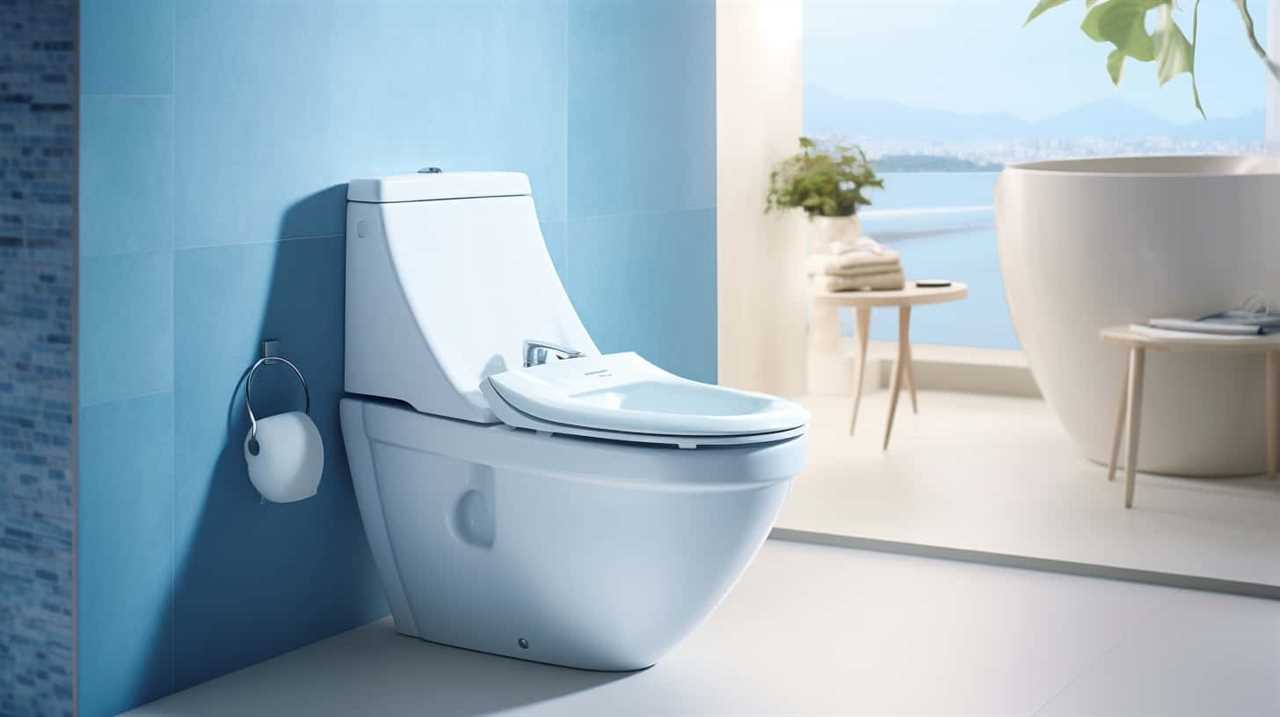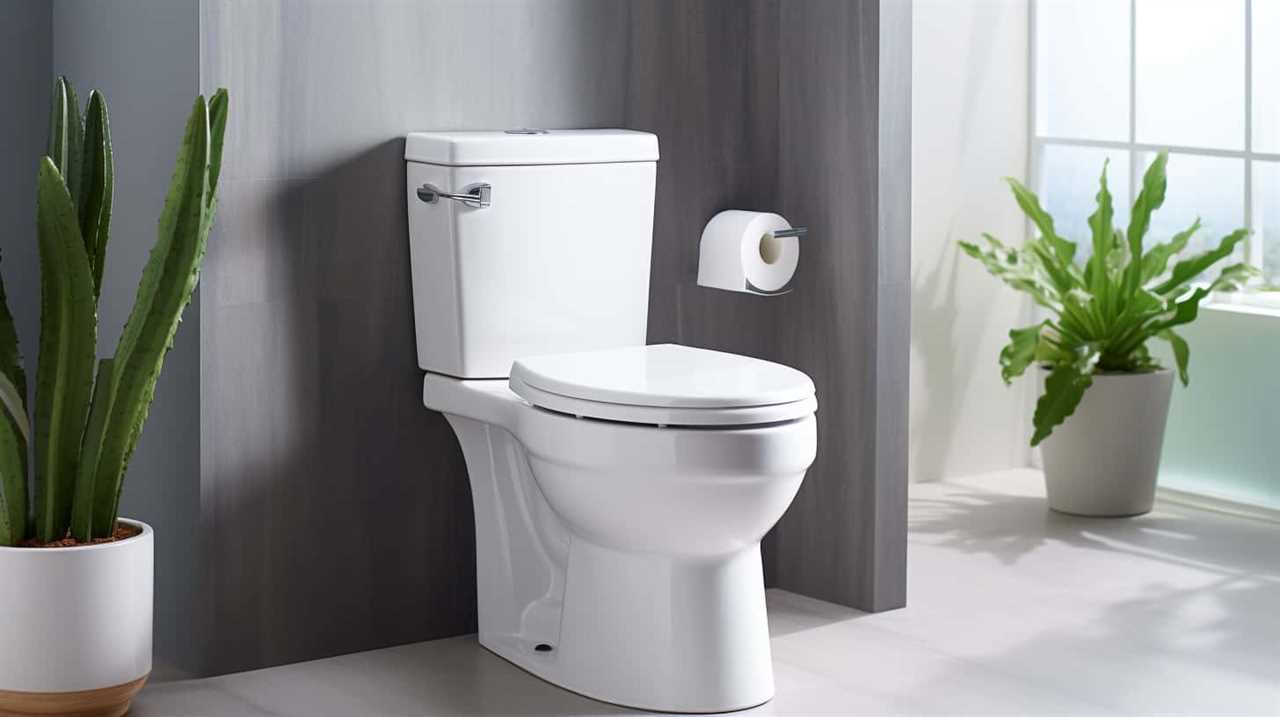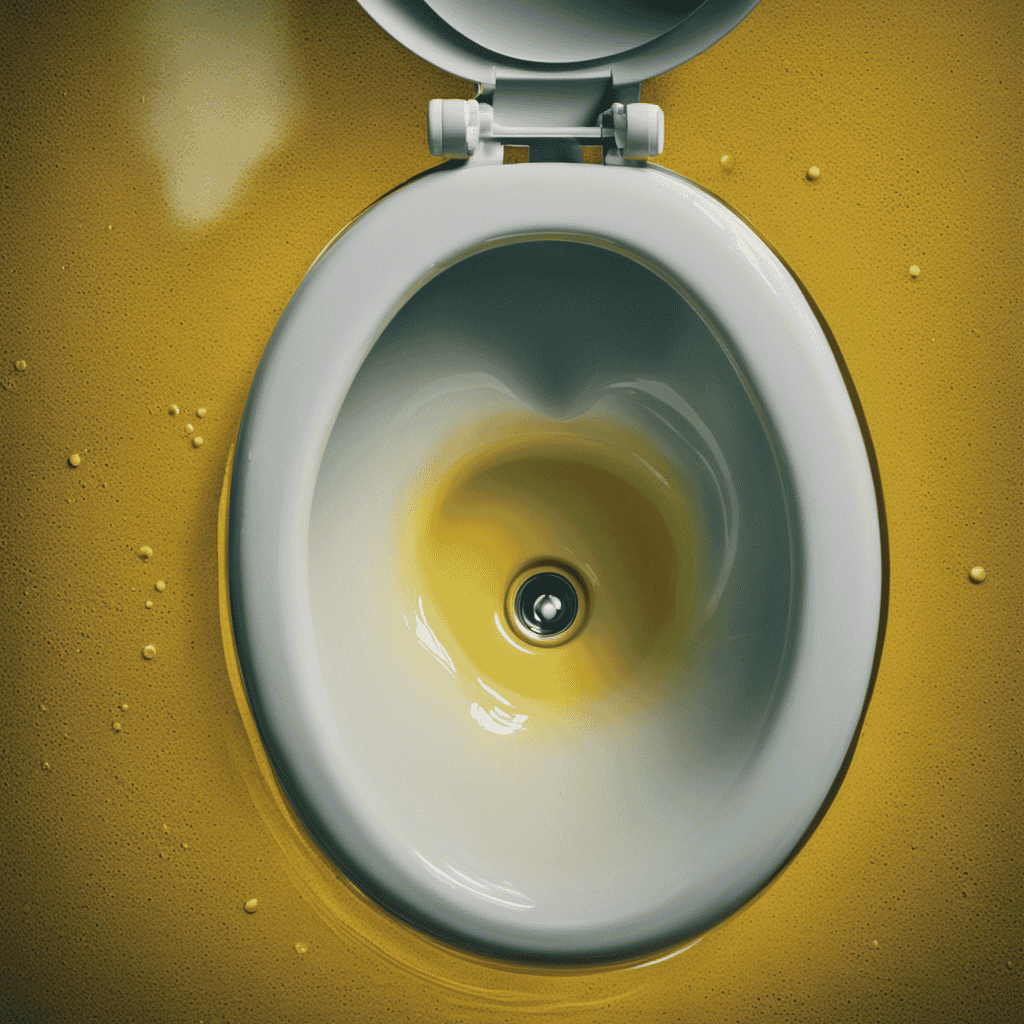Have you ever pondered whether it’s acceptable to shut off your toilet’s water supply? Look no further, because we have the information you seek.
In this article, we’ll dive into the reasons why you may need to shut off the water, the potential risks involved, and the benefits of doing so.
We’ll also provide you with step-by-step instructions on how to safely turn off the water and how to restore the water supply when needed.
So, let’s get started on mastering the art of water control!

Key Takeaways
- Turning off the water to the toilet is recommended during maintenance or repairs to prevent water damage and flooding.
- It helps conserve water, especially in case of leaks or extended periods of non-use.
- Turning off the water supply is essential for addressing common toilet problems like clogs and running water.
- It ensures personal safety by minimizing the risk of flooding or injury from pressurized water.
When to Turn off the Water
We recommend turning off the water to the toilet when performing maintenance or repairs. Knowing when to turn off the water is crucial to ensure a smooth and efficient process.
The water shut off procedure should be followed before starting any work on the toilet to prevent any potential water damage or flooding. It’s important to turn off the water supply whenever you need to replace parts, fix leaks, or make any adjustments to the toilet. This will help you avoid any unnecessary water wastage and potential accidents.
By performing this simple step, you can confidently proceed with your maintenance or repair tasks without worrying about any water-related issues.
Now, let’s explore the reasons for shutting off the water in more detail.

Reasons for Shutting off the Water
There are several reasons why it may be necessary to shut off the water to a toilet.
Firstly, plumbing repairs and maintenance often require the water supply to be turned off to avoid any potential leaks or water damage.
Secondly, shutting off the water to a toilet can also help conserve water, especially if there’s a leak or if the toilet isn’t being used for an extended period of time.
Lastly, turning off the water supply to a toilet can prevent water damage in case of a malfunction or overflow.

Plumbing Repairs and Maintenance
When performing plumbing repairs and maintenance, it’s essential to shut off the water for various reasons. Here are three important reasons why shutting off the water is necessary:
- Preventing leaks: Shutting off the water supply is crucial to prevent leaks during repairs. By turning off the water, you eliminate the risk of water escaping from the pipes and causing damage to your property.
- Addressing common toilet problems: Turning off the water is often necessary when dealing with common toilet issues like clogs or running water. By shutting off the water, you can safely inspect and repair the toilet without the risk of water overflowing or causing further damage.
- Ensuring personal safety: Shutting off the water supply is vital for your safety when working on plumbing repairs. By cutting off the water source, you minimize the risk of accidental flooding or injury from pressurized water.
Water Conservation Benefits
To conserve water, it’s important to shut off the water supply to the toilet. Implementing water conservation methods is crucial in today’s world, where the importance of water conservation can’t be overstated. By shutting off the water to the toilet, you can significantly reduce water waste and contribute to water conservation efforts.
This simple action can have a big impact on water usage, particularly considering that toilets are among the largest water consumers in a household. By turning off the water supply when the toilet isn’t in use, you can save a substantial amount of water over time. This not only helps to preserve this precious resource but also lowers your water bills.
Now let’s explore how shutting off the water can also prevent water damage.

Preventing Water Damage
By shutting off the water supply to our toilet, we can prevent potential water damage and protect our home. Water damage prevention is crucial to maintaining the structural integrity of our house and preventing costly repairs.
Here are three effective water shut off techniques to help prevent water damage:
- Install a shut-off valve: A shut-off valve allows you to quickly turn off the water supply to the toilet in case of a leak or overflow. This can help minimize the amount of water that’s released and prevent extensive damage.
- Regularly inspect and maintain the toilet: Check for any signs of leaks, cracks, or worn-out parts. Replace faulty components promptly to prevent water damage.
- Use a water alarm: Water alarms detect excess moisture or leaks near the toilet and sound an alert. This early warning system can help you identify and address potential water damage before it becomes a major issue.
Potential Risks of Turning off the Water
Turning off the water to a toilet can pose potential risks to the plumbing system and the surrounding area.
One of the main risks is the potential for damages to the plumbing, such as leaks or burst pipes, when turning the water supply back on.

Additionally, there’s a risk of flooding if the water isn’t properly turned off or if there are any issues with the shut-off valve.
It’s important to take these risks into consideration before deciding to turn off the water to a toilet.
Damages to Plumbing
When we turn off the water to the toilet, there’s a potential risk of causing damages to the plumbing. It’s important to be aware of these risks and take precautionary measures to prevent any potential issues. Here are three potential damages that can occur when water to the toilet is turned off:
- Preventing leaks: When the water supply is shut off, the seals and valves in the toilet may dry out and become brittle over time. This can lead to leaks when the water is turned back on, causing water damage to the surrounding areas.
- Water pressure management: Turning off the water to the toilet can disrupt the balance of water pressure in the plumbing system. This can lead to issues such as water hammer, where the sudden change in pressure causes loud banging noises in the pipes.
- Potential pipe damage: If the water is turned off for an extended period, the pipes may become stagnant and corroded. This can weaken the pipes and increase the risk of pipe bursts or leaks when the water supply is restored.
To avoid these potential damages, it’s recommended to consult with a professional plumber for guidance on proper water shut-off procedures and to ensure the plumbing system is properly maintained.

Risk of Flooding
To continue discussing the potential risks of turning off the water to the toilet, one significant concern is the risk of flooding. When the water supply to the toilet is turned off, there’s a possibility of water damage, particularly if there’s a malfunction or leak in the plumbing system. If the shut-off valve isn’t functioning properly or if there’s a sudden increase in water pressure, it can lead to a burst pipe or a leak that can cause extensive water damage to the surrounding areas.
This is why it’s crucial to ensure that the shut-off valve is in good working condition and to regularly inspect the plumbing system for any signs of leakage or damage. By maintaining the shut-off valve and promptly addressing any plumbing issues, the risks of water damage can be minimized.
With this understanding of the potential risks involved, let’s now explore the benefits of turning off the water to the toilet.
Benefits of Turning off the Water
How can we maximize the benefits of shutting off the water to our toilets? Turning off the water to our toilets can have several advantages, both in terms of water conservation and maintenance benefits. Here are three ways we can make the most out of this practice:

- Water conservation: By shutting off the water to our toilets when they aren’t in use, we can significantly reduce water waste. This simple action can help us conserve a precious resource and contribute to a more sustainable environment.
- Maintenance benefits: Turning off the water to our toilets can prevent potential leaks and avoid water damage. By regularly shutting off the water supply, we can identify and address any issues before they become major problems, saving us time, money, and hassle in the long run.
- Awareness and mindfulness: Shutting off the water to our toilets encourages us to be more mindful of our water usage. It reminds us to be more conscious of our actions and to take responsibility for conserving water, not just in our toilets but in all aspects of our daily lives.
How to Safely Turn off the Water
When it comes to turning off the water to your toilet, it’s important to follow proper techniques to ensure safety and prevent any damage.
First, locate the shut-off valve, usually located near the base of the toilet. Turn the valve clockwise to shut off the water supply.
Remember to take necessary safety precautions, such as wearing gloves and using a towel to catch any excess water.
Proper Water Shut-Off Technique
We always recommend using a wrench to securely tighten the shut-off valve in order to safely turn off the water to the toilet. Proper water shut-off techniques are crucial, especially in emergencies when you need to quickly stop the water flow.

Here are three important steps to follow when turning off the water supply:
- Locate the shut-off valve: The shut-off valve is usually located near the base of the toilet, either on the wall or on the floor. It’s typically a small handle or lever that you can turn to stop the water flow.
- Turn off the valve clockwise: To shut off the water, use a wrench to turn the valve clockwise until it’s fully closed. This will stop the water from flowing into the toilet.
- Test the shut-off: After closing the valve, flush the toilet to check if the water flow has stopped completely. If the water continues to flow, you may need to tighten the valve further or seek professional assistance.
Safety Precautions When Turning off Water
To ensure a safe water shut-off process, it’s important to take certain precautions. When turning off the water, there are a few safety measures that should be followed to avoid potential dangers.
First and foremost, it’s crucial to locate the main water shut-off valve. This valve is typically found near the water meter or where the main water line enters your home.
Before turning off the water, it’s recommended to wear protective gloves and safety glasses to prevent any injuries.

When shutting off the valve, it’s essential to turn it clockwise until it’s fully closed. This will stop the flow of water and prevent any leaks or damage.
Always be cautious of any electrical equipment or appliances that may be affected by the water shut-off.
Tools Needed for Turning off the Water
Before you can turn off the water to your toilet, it’s important to know what tools are needed. Here are the three essential tools you’ll need:
- Adjustable Wrench: This tool is necessary for loosening and tightening the water supply line connection. Make sure to choose an adjustable wrench that fits the size of the supply line nut.
- Slip-Joint Pliers: These pliers are useful for gripping and turning the valve handle. They’ve an adjustable jaw that allows you to adjust the size according to the valve’s dimensions.
- Bucket or Towels: It’s crucial to have a bucket or towels on hand to catch any water that may leak during the process. This will help prevent any water damage to your bathroom floor.
Steps to Turning off the Water
To turn off the water to your toilet, start by locating the shut-off valve near the base of the toilet. This valve is usually located on the wall behind the toilet or on the water supply line leading to the toilet. Once you have located the valve, turn it clockwise until it’s fully closed. This will stop the flow of water to the toilet.

It’s important to use the proper water shut off technique to ensure that the valve is fully closed and there are no leaks. When turning off the water, it’s also important to take safety precautions. Make sure to wear protective gloves and goggles to prevent any potential injuries.
Additionally, if you’re unsure about turning off the water or if you encounter any difficulties, it’s recommended to consult a professional plumber for assistance.
Turning off the water for a short period of time, such as when performing repairs or maintenance, is generally safe. However, if you plan to turn off the water for an extended period, it’s important to take precautions to prevent any damage or issues that may arise.
How Long Can the Water Be Turned off
While it’s generally safe to turn off the water to your toilet for a short period of time, you may be wondering how long the water can actually be turned off. In a water outage or emergency situations, it’s crucial to know the limitations to avoid any potential damage or inconvenience.

Here are the key factors to consider when determining how long you can turn off the water to your toilet:
- Storage Capacity: The duration depends on your toilet’s storage capacity. Most toilets can hold enough water for a few flushes, typically around 1.6 gallons per flush. However, this may vary depending on the model and size of your toilet tank.
- Usage: The number of individuals using the toilet and the frequency of use will impact how long the water can be turned off. If there are fewer people in the household or limited toilet usage, the water can last longer.
- Alternative Water Sources: It’s essential to have alternative water sources available during a water outage. This can include stored water, water from a nearby stream or lake (if safe), or water obtained from emergency water supplies. Having these sources can extend the duration of the water outage without causing inconvenience.
Precautions to Take When Water Is Turned off
When the water to our toilet is turned off, we should take certain precautions to ensure its proper functioning and avoid any potential issues. One important precaution is to prevent water contamination during the shut-off period. To do this, it is recommended to close the toilet lid and cover it with plastic wrap or a towel to prevent any foreign substances from entering the bowl. Additionally, it is essential to minimize water usage during the shut-off period to conserve water. This can be done by refraining from flushing the toilet unnecessarily and using alternative methods, such as pouring water manually into the bowl to flush waste. By following these precautions, we can maintain the toilet’s hygiene and minimize water wastage during the water shut-off.
| Precautions to Take When Water Is Turned off |
|---|
| Close the toilet lid and cover it with plastic wrap or a towel |
| Minimize water usage by refraining from unnecessary flushing |
| Use alternative methods, such as manually pouring water into the bowl to flush waste |
Signs That Indicate the Water Should Be Turned off
We recommend turning off the water to the toilet if there’s a leak or if repairs are needed. Here are three signs that indicate it’s time to turn off the water:
- Constant running water: If you hear the sound of water running in your toilet even when it hasn’t been recently flushed, it could indicate a problem with the fill valve or flapper. In this case, turning off the water can prevent water waste and potential damage.
- Water pooling around the base: If you notice water pooling around the base of the toilet, it could be a sign of a leak. Turning off the water immediately can help prevent further damage to your bathroom floor and subfloor.
- Weak flushing or incomplete flush: If your toilet isn’t flushing properly or if the flush is weak, it could be a sign of a clog or a problem with the water supply. Turning off the water before attempting to fix the issue can help avoid potential overflow or further damage to the plumbing system.
When encountering any of these signs, it’s important to take the necessary precautions and follow the appropriate steps to turn off the water to the toilet.

How to Restore the Water Supply
To restore the water supply to the toilet, it’s important to follow a few simple steps to ensure a smooth transition from turning off the water.
First, turn the water supply valve back on slowly to avoid any sudden pressure surges.
Check for any leaks or drips around the valve or the toilet connections.
If there are no leaks, flush the toilet to allow water to fill up the tank and bowl.

If the water pressure is low, check the main water supply valve to ensure it’s fully open.
Additionally, inspect the toilet fill valve and adjust it if necessary to restore proper water flow.
Common Mistakes to Avoid When Turning the Water Back on
One common mistake to avoid when restoring the water supply to the toilet is rushing to turn the water back on without checking for leaks or drips. This can lead to potential damage and costly repairs. To ensure a successful water restoration process, it’s important to follow proper technique and avoid these common mistakes:
- Inspect the water supply valve: Before turning the water back on, thoroughly check the water supply valve for any signs of leaks or damage. If you notice any issues, it’s crucial to address them before proceeding.
- Slowly turn on the water: Instead of quickly turning the water supply valve back on, gradually open it to allow the water to flow smoothly. This helps prevent sudden water pressure and potential pipe damage.
- Check for leaks and drips: Once the water is flowing, carefully examine the toilet and surrounding areas for any signs of leaks or drips. If you spot any, immediately turn off the water supply and address the issue before further damage occurs.
Final Tips and Considerations
Before proceeding, it’s important to consider a few final tips and factors related to turning off the water to your toilet.

These final tips will help ensure a smooth process and minimize any potential risks or damages.
Firstly, it’s crucial to have a clear understanding of the location of your main water shut-off valve. Familiarize yourself with its operation and ensure it’s easily accessible.
Secondly, make sure to turn off the water supply to the toilet gently to avoid any sudden pressure changes that could cause leaks or damage to the plumbing system.
Lastly, after turning off the water, consider implementing water restoration techniques to remove any excess water and prevent any potential water damage.

Conclusion
In conclusion, turning off the water to a toilet can be a necessary and beneficial action in certain situations. It helps prevent potential risks such as leaks, water damage, and excessive water consumption.
By following the proper steps and avoiding common mistakes, one can safely turn off and restore the water supply. It’s important to pay attention to signs indicating the need to turn off the water and to handle the process with precision and care.










